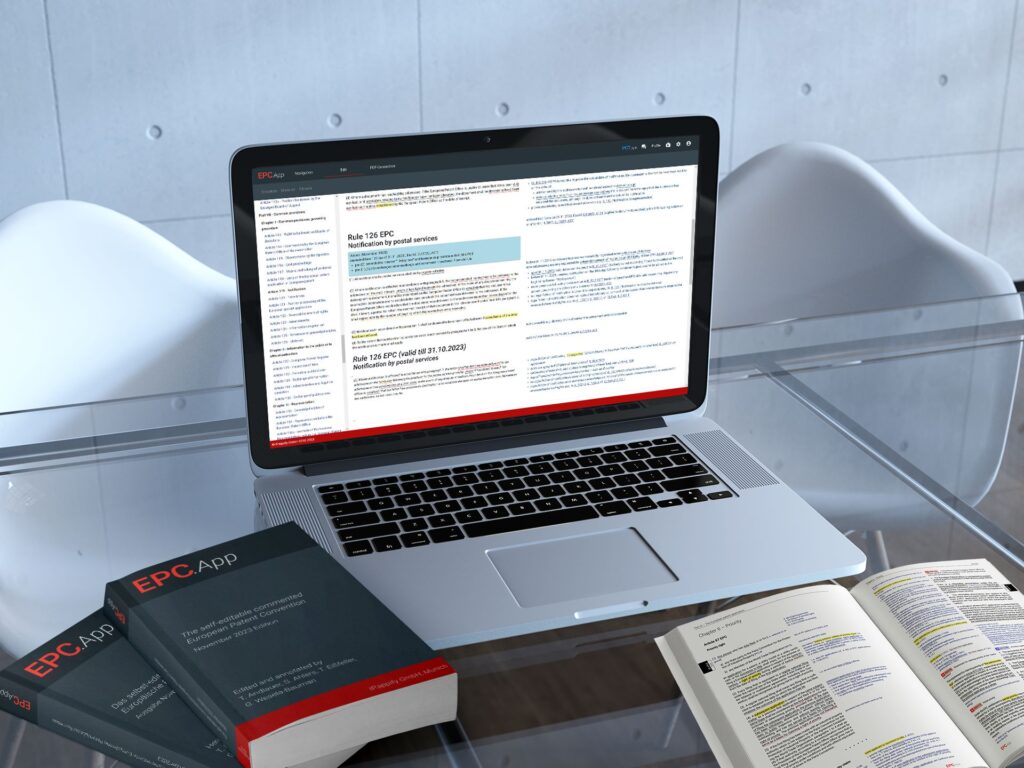We completed this year’s second update of our EPC.App reference book to legal status of 1st November 2023. As always, the English and German versions are synchronized in content. This meanwhile 11th edition of our EPC commentary covers all Official Journal articles until October 2023 with thereby implied changes of EPC provisions and is dedicated for use in EQE 20241.

Key changes since the last update in April 2023 were:
- The abandonment of the 10-day rule as of 1 November 2023 by amendments to Rules 126, 127 and 131 (open in EPC.App at A. 119). This change of long-lived practice came with some lead time and has already been reported one year ago on this Blog. Now, the 10-day rule of the EPC is finally history and harmonized with the 7-day rule of R.80.6 PCT. Instead of adding ten days to the start of a period triggered by a notification from the EPO, the date which the document bears counts directly, except if the delivery period exceeds seven days. The new provision applies to all documents notified by the EPO bearing a date on or after 01 November 2023. For the EQE, either the old or the new rules can be used, with the new ones being default and the old ones requiring indication by the candidate.
- The EBoA decisions G 1/22 + G 2/22 have been issued (open in EPC.App at A. 87). They confirmed that the EPO is competent to assess entitlement of priority, but newly specified that there is a rebuttable presumption that the applicant claiming priority is entitled to do so. This effectively confers a change of paradigm which sets the requirements for a valid transfer of priority to lowest standards. In the future, it will lead to less patents being revoked for not validly claiming priority. Reviews of this particular and other BoA decisions by Daniel X. Thomas can be found in the CASELAW category of this blog.
- Another interesting newly issued decision was J 5/23 which clarified that a signature for an assignment (at A. 72) must be a handwritten depiction of someone’s name (in contrast with the EPO so far allowing qualified electronic signatures). The integrated case law database of the online EPC.App has again been complemented by all BoA decisions published until end of October 2023. Decisions thereof can be added or cited in personal annotations as needed using the self-editing functions (illustrated in this video).
- Digitalization of EPO proceedings is moving forward with the introduction of a Contingency Upload Service and several changes to MyEPO Portfolio (in EPC.App at A. 75). There is now a broad spectrum of user categories allowed to receive access and the amount of available procedural actions is increasing step by step. A shared area is introduced for more interactive informal interviews in examination and changes of representation are made possible. Moreover, a two-step verification as future replacement of smartcards has been initiated.
- The UPCA entered into force on 1 June 2023. The UPCA itself as well as the EU regulations on unitary patent protection are not fully reproduced in the author scope of EPC.App, and comments to related EPC provisions had been added before. However, several information on practice and procedures before the EPO relating unitary patents has been newly released, such as the continued option to file early requests and to pay renewal fees via EPO deposit accounts (at A. 142).
The above links to the online versions of the book can be followed when being logged-in. A free one month test account is available, which does not extend automatically after expiry.
As usual, all changes of the update are automatically included in the online version on the next login. And as part of our update service, changes are additionally indicated by about 40 brief blue update notes in the App as shown in the screen above and further explained in the FAQs. Of course, self-edited user content from before the update is retained in the respective personal storage on the webserver, and can be exported into the printable PDF offline version so as to avoid time-consuming transfer of handwritten annotations to the new edition. A 2-minute video illustrating the update process and related functions can also be found in our youtube channel.
To further avoid the need of replacing pages in a folder, a customized color paperback with up-to-date content and typed user comments can be ordered via our integrated print-on-demand service (see image above). This service has recently received a strong improvement of paper and binding quality as reported here.
Update: For those who still prefer to start with a classical printed book, we published also the EPC.App November 2023 Edition as stand-alone black-and-white paperback. The book is available in English and German via Amazon.
1 Parts coming into force on 1 November after the EQE cut-off date 31 October are clearly indicated in the book. This year, basically OJ 2023, A89 about MyEPO portfolio and the 10-day rule abolition which is exceptionally considered in EQE 2024. In practice, it is anyway not a realistic fear to get punished in the EQE for applying provisions which enter into force after the cut-off. It is rather advisable to become familiar with changed provisions early.
Comments
Leave a comment